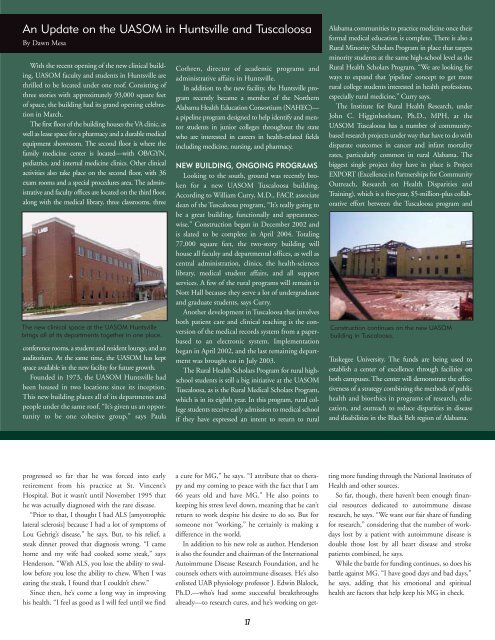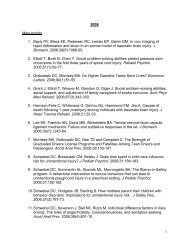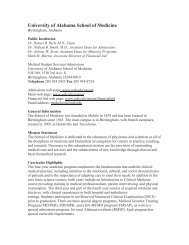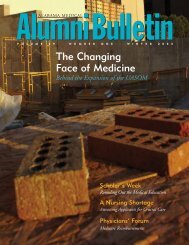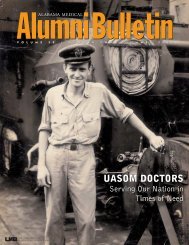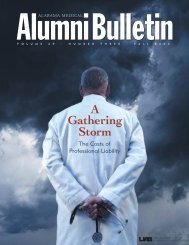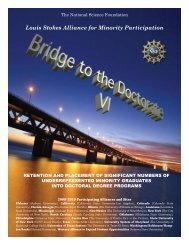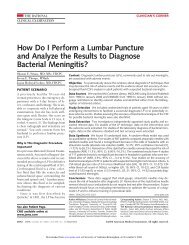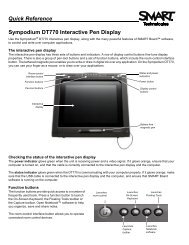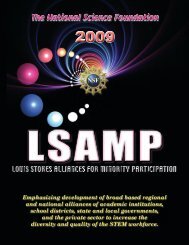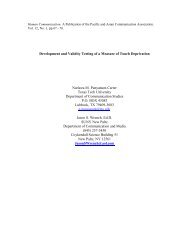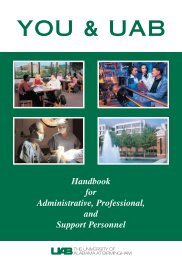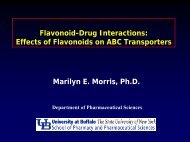the pursuit of parkinson's - The University of Alabama at Birmingham
the pursuit of parkinson's - The University of Alabama at Birmingham
the pursuit of parkinson's - The University of Alabama at Birmingham
You also want an ePaper? Increase the reach of your titles
YUMPU automatically turns print PDFs into web optimized ePapers that Google loves.
An Upd<strong>at</strong>e on <strong>the</strong> UASOM in Huntsville and Tuscaloosa<br />
By Dawn Mesa<br />
With <strong>the</strong> recent opening <strong>of</strong> <strong>the</strong> new clinical building,<br />
UASOM faculty and students in Huntsville are<br />
thrilled to be loc<strong>at</strong>ed under one ro<strong>of</strong>. Consisting <strong>of</strong><br />
three stories with approxim<strong>at</strong>ely 93,000 square feet<br />
<strong>of</strong> space, <strong>the</strong> building had its grand opening celebr<strong>at</strong>ion<br />
in March.<br />
<strong>The</strong> first floor <strong>of</strong> <strong>the</strong> building houses <strong>the</strong> VA clinic, as<br />
well as lease space for a pharmacy and a durable medical<br />
equipment showroom. <strong>The</strong> second floor is where <strong>the</strong><br />
family medicine center is loc<strong>at</strong>ed—with OB/GYN,<br />
pedi<strong>at</strong>rics, and internal medicine clinics. O<strong>the</strong>r clinical<br />
activities also take place on <strong>the</strong> second floor, with 36<br />
exam rooms and a special procedures area. <strong>The</strong> administr<strong>at</strong>ive<br />
and faculty <strong>of</strong>fices are loc<strong>at</strong>ed on <strong>the</strong> third floor,<br />
along with <strong>the</strong> medical library, three classrooms, three<br />
<strong>The</strong> new clinical space <strong>at</strong> <strong>the</strong> UASOM Huntsville<br />
brings all <strong>of</strong> its departments toge<strong>the</strong>r in one place.<br />
conference rooms, a student and resident lounge, and an<br />
auditorium. At <strong>the</strong> same time, <strong>the</strong> UASOM has kept<br />
space available in <strong>the</strong> new facility for future growth.<br />
Founded in 1973, <strong>the</strong> UASOM Huntsville had<br />
been housed in two loc<strong>at</strong>ions since its inception.<br />
This new building places all <strong>of</strong> its departments and<br />
people under <strong>the</strong> same ro<strong>of</strong>. “It’s given us an opportunity<br />
to be one cohesive group,” says Paula<br />
Cothren, director <strong>of</strong> academic programs and<br />
administr<strong>at</strong>ive affairs in Huntsville.<br />
In addition to <strong>the</strong> new facility, <strong>the</strong> Huntsville program<br />
recently became a member <strong>of</strong> <strong>the</strong> Nor<strong>the</strong>rn<br />
<strong>Alabama</strong> Health Educ<strong>at</strong>ion Consortium (NAHEC)—<br />
a pipeline program designed to help identify and mentor<br />
students in junior colleges throughout <strong>the</strong> st<strong>at</strong>e<br />
who are interested in careers in health-rel<strong>at</strong>ed fields<br />
including medicine, nursing, and pharmacy.<br />
NEW BUILDING, ONGOING PROGRAMS<br />
Looking to <strong>the</strong> south, ground was recently broken<br />
for a new UASOM Tuscaloosa building.<br />
According to William Curry, M.D., FACP, associ<strong>at</strong>e<br />
dean <strong>of</strong> <strong>the</strong> Tuscaloosa program, “It’s really going to<br />
be a gre<strong>at</strong> building, functionally and appearancewise.”<br />
Construction began in December 2002 and<br />
is sl<strong>at</strong>ed to be complete in April 2004. Totaling<br />
77,000 square feet, <strong>the</strong> two-story building will<br />
house all faculty and departmental <strong>of</strong>fices, as well as<br />
central administr<strong>at</strong>ion, clinics, <strong>the</strong> health-sciences<br />
library, medical student affairs, and all support<br />
services. A few <strong>of</strong> <strong>the</strong> rural programs will remain in<br />
Nott Hall because <strong>the</strong>y serve a lot <strong>of</strong> undergradu<strong>at</strong>e<br />
and gradu<strong>at</strong>e students, says Curry.<br />
Ano<strong>the</strong>r development in Tuscaloosa th<strong>at</strong> involves<br />
both p<strong>at</strong>ient care and clinical teaching is <strong>the</strong> conversion<br />
<strong>of</strong> <strong>the</strong> medical records system from a paperbased<br />
to an electronic system. Implement<strong>at</strong>ion<br />
began in April 2002, and <strong>the</strong> last remaining department<br />
was brought on in July 2003.<br />
<strong>The</strong> Rural Health Scholars Program for rural highschool<br />
students is still a big initi<strong>at</strong>ive <strong>at</strong> <strong>the</strong> UASOM<br />
Tuscaloosa, as is <strong>the</strong> Rural Medical Scholars Program,<br />
which is in its eighth year. In this program, rural college<br />
students receive early admission to medical school<br />
if <strong>the</strong>y have expressed an intent to return to rural<br />
<strong>Alabama</strong> communities to practice medicine once <strong>the</strong>ir<br />
formal medical educ<strong>at</strong>ion is complete. <strong>The</strong>re is also a<br />
Rural Minority Scholars Program in place th<strong>at</strong> targets<br />
minority students <strong>at</strong> <strong>the</strong> same high-school level as <strong>the</strong><br />
Rural Health Scholars Program. “We are looking for<br />
ways to expand th<strong>at</strong> ‘pipeline’ concept to get more<br />
rural college students interested in health pr<strong>of</strong>essions,<br />
especially rural medicine,” Curry says.<br />
<strong>The</strong> Institute for Rural Health Research, under<br />
John C. Higginbotham, Ph.D., MPH, <strong>at</strong> <strong>the</strong><br />
UASOM Tuscaloosa has a number <strong>of</strong> communitybased<br />
research projects under way th<strong>at</strong> have to do with<br />
dispar<strong>at</strong>e outcomes in cancer and infant mortality<br />
r<strong>at</strong>es, particularly common in rural <strong>Alabama</strong>. <strong>The</strong><br />
biggest single project <strong>the</strong>y have in place is Project<br />
EXPORT (Excellence in Partnerships for Community<br />
Outreach, Research on Health Disparities and<br />
Training), which is a five-year, $5-million-plus collabor<strong>at</strong>ive<br />
effort between <strong>the</strong> Tuscaloosa program and<br />
Construction continues on <strong>the</strong> new UASOM<br />
building in Tuscaloosa.<br />
Tuskegee <strong>University</strong>. <strong>The</strong> funds are being used to<br />
establish a center <strong>of</strong> excellence through facilities on<br />
both campuses. <strong>The</strong> center will demonstr<strong>at</strong>e <strong>the</strong> effectiveness<br />
<strong>of</strong> a str<strong>at</strong>egy combining <strong>the</strong> methods <strong>of</strong> public<br />
health and bioethics in programs <strong>of</strong> research, educ<strong>at</strong>ion,<br />
and outreach to reduce disparities in disease<br />
and disabilities in <strong>the</strong> Black Belt region <strong>of</strong> <strong>Alabama</strong>.<br />
progressed so far th<strong>at</strong> he was forced into early<br />
retirement from his practice <strong>at</strong> St. Vincent’s<br />
Hospital. But it wasn’t until November 1995 th<strong>at</strong><br />
he was actually diagnosed with <strong>the</strong> rare disease.<br />
“Prior to th<strong>at</strong>, I thought I had ALS [amyotrophic<br />
l<strong>at</strong>eral sclerosis] because I had a lot <strong>of</strong> symptoms <strong>of</strong><br />
Lou Gehrig’s disease,” he says. But, to his relief, a<br />
steak dinner proved th<strong>at</strong> diagnosis wrong. “I came<br />
home and my wife had cooked some steak,” says<br />
Henderson. “With ALS, you lose <strong>the</strong> ability to swallow<br />
before you lose <strong>the</strong> ability to chew. When I was<br />
e<strong>at</strong>ing <strong>the</strong> steak, I found th<strong>at</strong> I couldn’t chew.”<br />
Since <strong>the</strong>n, he’s come a long way in improving<br />
his health. “I feel as good as I will feel until we find<br />
a cure for MG,” he says. “I <strong>at</strong>tribute th<strong>at</strong> to <strong>the</strong>rapy<br />
and my coming to peace with <strong>the</strong> fact th<strong>at</strong> I am<br />
66 years old and have MG.” He also points to<br />
keeping his stress level down, meaning th<strong>at</strong> he can’t<br />
return to work despite his desire to do so. But for<br />
someone not “working,” he certainly is making a<br />
difference in <strong>the</strong> world.<br />
In addition to his new role as author, Henderson<br />
is also <strong>the</strong> founder and chairman <strong>of</strong> <strong>the</strong> Intern<strong>at</strong>ional<br />
Autoimmune Disease Research Found<strong>at</strong>ion, and he<br />
counsels o<strong>the</strong>rs with autoimmune diseases. He’s also<br />
enlisted UAB physiology pr<strong>of</strong>essor J. Edwin Blalock,<br />
Ph.D.—who’s had some successful breakthroughs<br />
already—to research cures, and he’s working on getting<br />
more funding through <strong>the</strong> N<strong>at</strong>ional Institutes <strong>of</strong><br />
Health and o<strong>the</strong>r sources.<br />
So far, though, <strong>the</strong>re haven’t been enough financial<br />
resources dedic<strong>at</strong>ed to autoimmune disease<br />
research, he says. “We want our fair share <strong>of</strong> funding<br />
for research,” considering th<strong>at</strong> <strong>the</strong> number <strong>of</strong> workdays<br />
lost by a p<strong>at</strong>ient with autoimmune disease is<br />
double those lost by all heart disease and stroke<br />
p<strong>at</strong>ients combined, he says.<br />
While <strong>the</strong> b<strong>at</strong>tle for funding continues, so does his<br />
b<strong>at</strong>tle against MG. “I have good days and bad days,”<br />
he says, adding th<strong>at</strong> his emotional and spiritual<br />
health are factors th<strong>at</strong> help keep his MG in check.<br />
17


